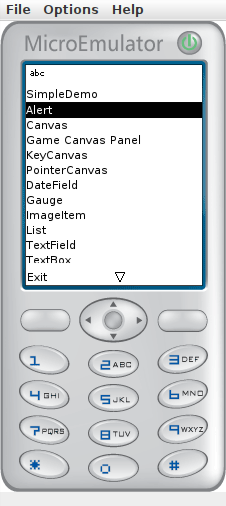|
Samsung SGH-T100
The Samsung SGH-T100 is a dual-band GSM mobile phone developed and manufactured by South Korean company Samsung Electronics, introduced at the CeBIT fair in 2002. It is a flip phone with a color display, and is an upgraded version of the SGH-A800 which had a monochrome internal LCD screen instead. The Samsung SGH-T100 was the first mobile phone to use a thin-film transistor active matrix LCD display; prior to the release of the SGH-T100 all phones had used passive matrix display technology. It was also the first GSM phone displaying 4096 shades of colours - previous colour phones like Ericsson T68 could only do 256 colours. The T100 became popular for its stylish looks, display and polyphonic ringtones, and was credited for bringing typically Japanese technologies to GSM markets like Europe. By 2003, the T100 had sold over 10million units worldwide, becoming Samsung's first to reach this milestone. The T100 was succeeded by Samsung SGH-T400. Above the T100, Samsung offered in ... [...More Info...] [...Related Items...] OR: [Wikipedia] [Google] [Baidu] |
Samsung SGH-A800
Samsung Group (; stylised as SΛMSUNG) is a South Korean multinational manufacturing conglomerate headquartered in the Samsung Town office complex in Seoul. The group consists of numerous affiliated businesses, most of which operate under the Samsung brand, and is the largest (business conglomerate) in South Korea. Samsung has the world's fifth-highest brand value. Founded in 1938 by Lee Byung-chul as a trading company, Samsung diversified into various sectors, including food processing, textiles, insurance, securities, and retail, over the next three decades. In the late 1960s, Samsung entered the electronics industry, followed by the construction and shipbuilding sectors in the mid-1970s—areas that would fuel its future growth. After Lee died in 1987, Samsung was divided into five business groups: Samsung Group, Shinsegae Group, CJ Group, Hansol Group, and JoongAng Group. Key affiliates of Samsung include Samsung Electronics, the world's largest information techn ... [...More Info...] [...Related Items...] OR: [Wikipedia] [Google] [Baidu] |
SK Telecom
SK Telecom Co., Ltd., abbreviated as SKT ( or ) is a South Korean wireless telecommunications operator and former film distributor and is part of the SK Group, one of the country's largest chaebols. It leads the local market with 50.5 percent share as of 2008. SK Telecom is the largest wireless carrier in South Korea, with 23 million subscribers as of Q4 2023. Since its creation in 1984, the company has evolved from a first generation analog cellular system, to second generation CDMA, then to the world's first third-generation synchronized IMT-2000 cellular system. SK Telecom also became the world's first carrier to commercialize HSDPA in May 2006. SK expanded into the landline market by acquiring second-rated fixed-line operator Hanaro Telecom in February 2008. The company's online brands include Nate, a web portal, June, a mobile multimedia service, Moneta, an e-banking mobile app, Nate Drive, a telematics service, and Digital Home, an online interface to remote-c ... [...More Info...] [...Related Items...] OR: [Wikipedia] [Google] [Baidu] |
Anycall
Anycall () was a South Korean mobile phone brand established by Samsung Electronics in 1993. It was once the most popular mobile phone brand in the country, having been the leader since 1995. Samsung mobile phones were sold through the Anycall brand in South Korea and the greater China region prior to 2011. The brand was eventually retired during the 2010s when it only remained in use for feature phones. Like other mobile phone brands in South Korea, they provided technology such as cameras, internet access, and digital TV through Digital Multimedia Broadcasting. Spokeswoman Lee Hyori was spokeswoman for Anycall from 2003 During this period, she starred in Anycall produced music videos such as "Anymotion", which features Anycall SCH-V600 by Lee Hyori Phone. In 2005, Hyori Lee starred in "Anyclub", a follow-up to the smash hit "Anymotion". In December 2006, she starred in a third installment, labeled "Anystar". The first music video starred Lee Hyori along with Eric Mun, while ... [...More Info...] [...Related Items...] OR: [Wikipedia] [Google] [Baidu] |
MPEG-4
MPEG-4 is a group of international standards for the compression of digital audio and visual data, multimedia systems, and file storage formats. It was originally introduced in late 1998 as a group of audio and video coding formats and related technology agreed upon by the ISO/IEC Moving Picture Experts Group (MPEG) (ISO/IEC JTC 1/SC29/WG11) under the formal standard ISO/IEC 14496 – ''Coding of audio-visual objects''. Uses of MPEG-4 include compression of audiovisual data for Internet video and CD distribution, voice (telephone, videophone) and broadcast television applications. The MPEG-4 standard was developed by a group led by Touradj Ebrahimi (later the JPEG president) and Fernando Pereira. Background MPEG-4 absorbs many of the features of MPEG-1 and MPEG-2 and other related standards, adding new features such as (extended) VRML support for 3D rendering, object-oriented composite files (including audio, video and VRML objects), support for externally specified ... [...More Info...] [...Related Items...] OR: [Wikipedia] [Google] [Baidu] |
J2ME
Java Platform, Micro Edition or Java ME is a computing platform for development and deployment of porting, portable code for embedded system, embedded and mobile devices (micro-controllers, sensors, gateways, mobile phones, personal digital assistants, TV set-top boxes, printers). Java ME was formerly known as Java 2 Platform, Micro Edition or J2ME. The platform uses the object-oriented programming, object-oriented java (programming language), Java programming language, and is part of the Java (software platform), Java software-platform family. It was designed by Sun Microsystems (now Oracle Corporation) and replaced a similar technology, PersonalJava. In 2013, with more than 3 billion Java ME enabled mobile phones in the market, the platform was in continued decline as smartphones have overtaken feature phones. History The platform used to be popular in feature phones, such as Nokia's Series 40 models. It was also supported on the Bada (operating system), B ... [...More Info...] [...Related Items...] OR: [Wikipedia] [Google] [Baidu] |
GPRS
General Packet Radio Service (GPRS), also called 2.5G, is a mobile data standard on the 2G cellular communication network's Global System for Mobile Communications, global system for mobile communications (GSM). Networks and mobile devices with GPRS started to roll out around the year 2001; it offered, for the first time on GSM networks, seamless data transmission using Packet switching, packet data for an "always-on" connection (eliminating the need to "dial-up"), so providing improved Internet access for World Wide Web, web, email, Wireless Application Protocol, WAP services, Multimedia Messaging Service (MMS) and others. Up until the rollout of GPRS, only circuit switched data was used in cellular networks, meaning that one or more radio channels were occupied for the entire duration of a data connection. On the other hand, on GPRS networks, data is broken into small packets and transmitted through available channels. This increased efficiency also gives it theoretical data ... [...More Info...] [...Related Items...] OR: [Wikipedia] [Google] [Baidu] |
Samsung SGH-T400
Samsung Group (; stylised as SΛMSUNG) is a South Korean multinational manufacturing conglomerate headquartered in the Samsung Town office complex in Seoul. The group consists of numerous affiliated businesses, most of which operate under the Samsung brand, and is the largest (business conglomerate) in South Korea. Samsung has the world's fifth-highest brand value. Founded in 1938 by Lee Byung-chul as a trading company, Samsung diversified into various sectors, including food processing, textiles, insurance, securities, and retail, over the next three decades. In the late 1960s, Samsung entered the electronics industry, followed by the construction and shipbuilding sectors in the mid-1970s—areas that would fuel its future growth. After Lee died in 1987, Samsung was divided into five business groups: Samsung Group, Shinsegae Group, CJ Group, Hansol Group, and JoongAng Group. Key affiliates of Samsung include Samsung Electronics, the world's largest information techn ... [...More Info...] [...Related Items...] OR: [Wikipedia] [Google] [Baidu] |
Ericsson T68
a T68i a T68m The Ericsson T68m (often called simply T68) is a candy-bar style mobile phone by Ericsson Mobile Communications. Launched in time for the 2001 Christmas season, the T68 was the first Ericsson mobile phone to have a colour screen, a passive LCD-STN with a resolution of 101×80 and 256 colours. Despite its diminute size (3.94×1.89×0.79 in or 100×48×20 mm, 2.96 oz or 84 g), it was one of the most feature-rich mobile phones at the time, with Bluetooth, IrDA port, GPRS 3+1, tri-band compatibility (900 MHz, 1800 MHz and 1900 MHz), SMS with T9 (predictive text), EMS, WAP, and customizable monophonic ring tones. At its release, the phone cost around € 500, GBP299 in the UK, in either two-tone grey or all-gold. Features A simple bitmap image editor was provided, allowing the creation of monochrome pictures by guiding a cursor around the canvas and setting or unsetting individual pixels (several 'brush' sizes were selectable to make this e ... [...More Info...] [...Related Items...] OR: [Wikipedia] [Google] [Baidu] |
Passive Matrix
Passive matrix addressing is an addressing scheme used in early liquid crystal displays (LCDs). It is a matrix addressing scheme, meaning that only ''m'' + ''n'' control signals are required to address an ''m'' × ''n'' display. A pixel in a passive matrix must maintain its state without active driving circuitry until it can be refreshed again. The signal is divided into a row or ''select signal'' and a column or ''video signal''. The select voltage determines the row that is being addressed and all ''n'' pixels on a row are addressed simultaneously. When pixels on a row are being addressed, a ''Vsel'' potential is applied, and all other rows are unselected with a ''Vunsel'' potential. The video signal or column potential is then applied with a potential for each ''m'' columns individually. An on-switched (lit) pixel corresponds to a ''Von'', an off-switched (unlit) corresponds to a ''Voff'' potential. The potential across pixel at selected row ''i'' and ... [...More Info...] [...Related Items...] OR: [Wikipedia] [Google] [Baidu] |
Active Matrix
Active matrix is a type of addressing scheme used in flat panel displays. It is a method of switching individual elements of a flat panel display, known as pixels. Each pixel is attached to a transistor and capacitor that ''actively'' maintain the pixel state while other pixels are being addressed, in contrast with the older passive matrix technology in which each pixel must maintain its state passively, without being driven by circuitry. Active matrix technology was invented by Bernard J. Lechner at RCA, using MOSFETs (metal–oxide–semiconductor field-effect transistors). Active matrix technology was first demonstrated as a feasible device using thin-film transistors (TFTs) by T. Peter Brody, Fang Chen Luo and their team at the Thin-Film Devices department of Westinghouse Electric Corporation in 1974, and the term was introduced into the literature in 1975. Given an ''m'' × ''n'' matrix, the number of connectors needed to address the display is ''m'' +&nbs ... [...More Info...] [...Related Items...] OR: [Wikipedia] [Google] [Baidu] |
Flip Phone
Clamshell design is a form factor commonly used in the design of electronic devices and other manufactured objects. It is inspired by the morphology of the clam. The form factor has been applied to handheld game consoles, mobile phones (where it is often called a "flip phone"), and especially laptop computers. Clamshell devices are usually made of two sections connected by a hinge, each section containing either a flat panel display or an alphanumeric keyboard/keypad, which can fold into contact together like a bivalve shell. Generally speaking, the interface components such as keys and display are kept inside the closed clamshell, protecting them from damage and unintentional use while also making the device shorter or narrower so it is easier to carry around. In many cases, opening the clamshell offers more surface area than when the device is closed, allowing interface components to be larger and easier to use than on devices which do not flip open. A disadvantage of the ... [...More Info...] [...Related Items...] OR: [Wikipedia] [Google] [Baidu] |


